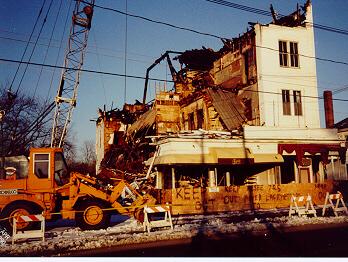By Herb Philbrick, RCN Staff
Hampton Union
Tuesday, January 30, 1990
[The following article is courtesy of The Hampton Union and Seacoast Online.]

The fire that destroyed the Odd Fellows Building in town early Saturday morning [January 27, 1990] brought an end to another chapter of Seacoast history spanning more than 100 years.
While the building was not built until the 1890s, the Odd Fellows had been in the area since the 1840s.
It was in 1848 that a group of leading citizens from six towns in the area met in the upstairs room of the C. N. Dodge Co. general store on Brimstone Hill in Hampton Falls, to hold the first meeting of Rockingham Odd Fellows Lodge Number 22.
Along with Charles Nealy Dodge, whose store provided the Odd Fellows with their first meeting place, the original roster of charter members reads like a who’s who of Seacoast area leaders in the 1800s: Charles and Nellie Akerman, Charles Batchelder, J. W. and Valeria Berry, Samuel and Emily Dow, Justin Drake, John and Ella Hoyt, John and Lizzie Locke, George and Josie Marston, Fred Sanborn, and others including the Browns: Abbie, Abel Charlette, Edwin, George, Laura, Lewis, Mary, Otis, Rhoda and William.
In 1883, no longer able to squeeze into the meeting room over Dodge’s store, the Odd Fellows moved to Hampton and for the next 12 years, the lodge room was located in Hampton Academy. Shortly after the move to Hampton, a companion lodge, the Winnacummet Rebekah Lodge was organized.
However, in 1893, faced with increasing membership, Lodge members decided to acquire their own Lodge Hall. On June 25, 1893, they purchased the land in the center of town from William A. and Jennie A. Champlin of Pawtucket, R.I.; Mary E. Whitman of East Greenwich, R.I.; and William A. Perry of New York, N.Y., for the princely sum of $1,000. That money was “duly paid” by Ebed L. Dalton, Abbot J. Joplin, and Charles P. Akerman, according to the deed in the Rockingham County Registry.
The contract bid was awarded to the lowest bidder, Abbot L. Joplin on Aug. 18, 1893. Work began immediately, and 14 months later the imposing structure, the largest and the tallest in Hampton, was completed.
The large hall, located on the second floor of the building, was dedicated at a semi-public meeting on Dec. 10, 1896. The first Lodge meeting, the 194th of Rockingham Lodge Number 22, I.O.O.F., was held five days later, on Tuesday, Dec. 15.
In the meantime, there had been talk around Hampton about the need for a town clock. And what better place, the town fathers decided, then in that nice beautiful steeple atop Odd Fellows Hall?
Agreeing to put a clock in the steeple as everyone would find out was easier said than done. In 1897, it was first discovered that the town’s $400 appropriation was not nearly enough to pay for the clock; and second, it was found that the clock wouldn’t fit in the steeple as constructed.
Fortunately, public-spirited citizen, John T. Brown, who had been raised in Hampton Falls offered to donate the money to pay for the town clock, and the town voted to give the Odd Fellows the $400 to “raise the tower 12 feet, buy a bell weighing at least 1,200 pounds, and install a first-class clock with four dials.”
One year later, work was completed — the steeple had been raised and the clock installed. And an agreement was struck where the Odd Fellows would lease the space to the town and the town would maintain the clock and steeple.
For many years thereafter, the half-ton bell not only rang out the hours, but for five minutes every night at 9 o’clock. That was s”curfew time” when all respectable children not in the company of adults had to be off the streets and in their homes.
And it rang 15 minutes morning, noon and night on Washington’s birthday, the Fourth of July, and Thanksgiving.
Earlier this month, trustees of the Odd Fellows approached town officials with an appeal to appropriate funds to strengthen the timbers supporting the clock and bell. The wood was rotting because of leaks, they said, and every time the huge bell rang it not only shook the whole building but it was cracking plaster in the walls.
Selectman Glyn Eastman agreed that the supporting platform was “in rough shape” but doubted that the town would allocate repair funds this fiscal year.
Last Saturday, Jan. 27, 1990, with the entire building engulfed in flames, firefighters heard the nearly century-old town-clock bell toll for the last time. It was 3 a.m.